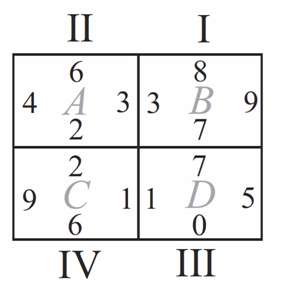2007 AMC 8 Problems/Problem 11: Difference between revisions
Basketball8 (talk | contribs) |
|||
| Line 3: | Line 3: | ||
Tiles <math>I, II, III</math> and <math>IV</math> are translated so one tile coincides with each of the rectangles <math>A, B, C</math> and <math>D</math>. In the final arrangement, the two numbers on any side common to two adjacent tiles must be the same. Which of the tiles is translated to Rectangle <math>C</math>? | Tiles <math>I, II, III</math> and <math>IV</math> are translated so one tile coincides with each of the rectangles <math>A, B, C</math> and <math>D</math>. In the final arrangement, the two numbers on any side common to two adjacent tiles must be the same. Which of the tiles is translated to Rectangle <math>C</math>? | ||
< | <asy> | ||
size(400); | |||
defaultpen(linewidth(0.8)); | |||
path p=origin--(8,0)--(8,6)--(0,6)--cycle; | |||
draw(p^^shift(8.5,0)*p^^shift(8.5,10)*p^^shift(0,10)*p); | |||
draw(shift(20,2)*p^^shift(28,2)*p^^shift(20,8)*p^^shift(28,8)*p); | |||
label("8", (4,6+10), S); | |||
label("6", (4+8.5,6+10), S); | |||
label("7", (4,6), S); | |||
label("2", (4+8.5,6), S); | |||
label("I", (4,6+10), N); | |||
label("II", (4+8.5,6+10), N); | |||
label("III", (4,6), N); | |||
label("IV", (4+8.5,6), N); | |||
label("3", (0,3+10), E); | |||
label("4", (0+8.5,3+10), E); | |||
label("1", (0,3), E); | |||
label("9", (0+8.5,3), E); | |||
label("7", (4,10), N); | |||
label("2", (4+8.5,10), N); | |||
label("0", (4,0), N); | |||
label("6", (4+8.5,0), N); | |||
label("9", (8,3+10), W); | |||
label("3", (8+8.5,3+10), W); | |||
label("5", (8,3), W); | |||
label("1", (8+8.5,3), W); | |||
label("A", (24,10), N); | |||
label("B", (32,10), N); | |||
label("C", (24,4), N); | |||
label("D", (32,4), N);</asy> | |||
<math>\mathrm{(A)}\ I \qquad \mathrm{(B)}\ II \qquad \mathrm{(C)}\ III \qquad \mathrm{(D)}\ IV \qquad \mathrm{(E)}</math> cannot be determined | <math>\mathrm{(A)}\ I \qquad \mathrm{(B)}\ II \qquad \mathrm{(C)}\ III \qquad \mathrm{(D)}\ IV \qquad \mathrm{(E)}</math> cannot be determined | ||
Revision as of 12:18, 9 December 2012
Problem
Tiles ![]() and
and ![]() are translated so one tile coincides with each of the rectangles
are translated so one tile coincides with each of the rectangles ![]() and
and ![]() . In the final arrangement, the two numbers on any side common to two adjacent tiles must be the same. Which of the tiles is translated to Rectangle
. In the final arrangement, the two numbers on any side common to two adjacent tiles must be the same. Which of the tiles is translated to Rectangle ![]() ?
?
![[asy] size(400); defaultpen(linewidth(0.8)); path p=origin--(8,0)--(8,6)--(0,6)--cycle; draw(p^^shift(8.5,0)*p^^shift(8.5,10)*p^^shift(0,10)*p); draw(shift(20,2)*p^^shift(28,2)*p^^shift(20,8)*p^^shift(28,8)*p); label("8", (4,6+10), S); label("6", (4+8.5,6+10), S); label("7", (4,6), S); label("2", (4+8.5,6), S); label("I", (4,6+10), N); label("II", (4+8.5,6+10), N); label("III", (4,6), N); label("IV", (4+8.5,6), N); label("3", (0,3+10), E); label("4", (0+8.5,3+10), E); label("1", (0,3), E); label("9", (0+8.5,3), E); label("7", (4,10), N); label("2", (4+8.5,10), N); label("0", (4,0), N); label("6", (4+8.5,0), N); label("9", (8,3+10), W); label("3", (8+8.5,3+10), W); label("5", (8,3), W); label("1", (8+8.5,3), W); label("A", (24,10), N); label("B", (32,10), N); label("C", (24,4), N); label("D", (32,4), N);[/asy]](http://latex.artofproblemsolving.com/7/e/7/7e7f71699fece62a1150cc80613baf59935980df.png)
![]() cannot be determined
cannot be determined
Solution
We first notice that tile III has a ![]() on the bottom and a
on the bottom and a ![]() on the right side. Since no other tile has a
on the right side. Since no other tile has a ![]() or a
or a ![]() , Tile III must be in rectangle
, Tile III must be in rectangle ![]() . Tile III also has a
. Tile III also has a ![]() on the left, so Tile IV must be in Rectangle
on the left, so Tile IV must be in Rectangle ![]() .
.
The answer is ![]()

See Also
| 2007 AMC 8 (Problems • Answer Key • Resources) | ||
| Preceded by Problem 10 |
Followed by Problem 12 | |
| 1 • 2 • 3 • 4 • 5 • 6 • 7 • 8 • 9 • 10 • 11 • 12 • 13 • 14 • 15 • 16 • 17 • 18 • 19 • 20 • 21 • 22 • 23 • 24 • 25 | ||
| All AJHSME/AMC 8 Problems and Solutions | ||









